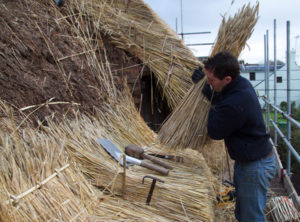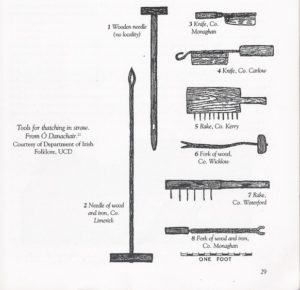The Art of Thatch
Cathy Koos
Across the world many countries including the United Kingdom have a rich history of thatched roofs. Once the roof of necessity for poor cottagers, thatch in the UK has recently become a status symbol due to the prohibitive cost of skilled artisans practicing this ancient craft.

Figure 1 East Meon Village History, Lyle Morgans, Master Thatcher, 2010
First showing up during the Bronze Age, early inhabitants wanting a roof for their dwelling would source the materials nearby – sheaves of wheat or straw, even bundles of heather in the far north. As basket weavers created practical carrying and storage containers, thatchers used similar materials to produce a giant weather-tight, rainproof basket for their homes.
For comparison, a contemporary composition roof in California generally runs about $25,000 and lasts about 25 years. A thatch roof will generally run about 25% more and, depending on the material, last anywhere from 20 to 50 or more years.
While thatch is somewhat a fire hazard, it is remarkably well-suited to England’s damp climate, and studies reveal no greater likelihood of a roof fire than traditional roof coverings. Like hair, thatch enjoys some damp, and in recent summer’s heat homeowners often wet down their thatch.
Its ability to slough off rain and foul weather is testament to the skill of the master thatcher. Thatch is deceptively simple in appearance but wielded in the proper hands, the tools needed to thatch a cottage have not changed much in several thousand years.

Figure 2, Thatching tools, Dept of Irish Folklore, U Dublin
A five-year apprenticeship under a master thatcher certifies a craftsperson in all the variations of plant material, roof styles, window surrounds, curves, and ridgelines.
Like the little-changed tools of the basket weaver, the master thatcher employs simple but precise tools such as rakes, forks, knives, and needles to manipulate and hold bundles of thatch in place.
Due to genetic modification and pesticides, the stems of modern wheat varieties do not hold up to the elements. Triticale wheat is an older, hardy variety and because some of the cottages are historically listed, the thatch material is specified. Contemporary thatchers find it difficult to source traditional raw materials, so some are growing their own straw triticale. To maintain the stem integrity, the growers must employ antique harvesters better suited to the antique wheat.

Figure 3 Nick Berry, Getty Images
Rain or shine, through wintry weather or hot, the thatcher must work. Once the bundles are placed, a hazel wood spar is pushed into place. Acting like a giant hair pin, the spar holds the material in place. Once in place, a mesh netting is stretched over the roof to keep birds and vermin from taking up occupancy.
And the finishing touch is the thatcher’s signature creature on the ridge line – a fox, a bird, a rabbit – each creature is like an ancient calling card, visible to all passersby.